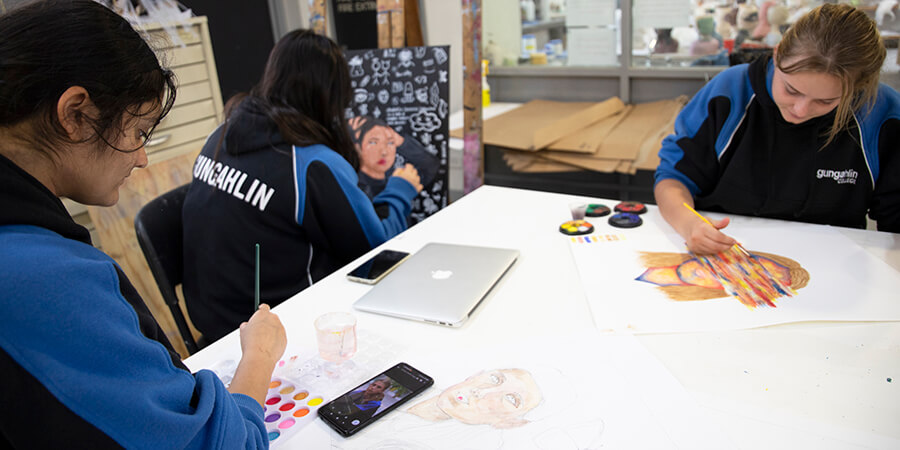
Course information
Students studying Visual Arts at our College experience self-expression through a range of media including Painting, Drawing, Printmaking, Ceramics and Sculpture. Students learn and develop a wide range of skills that allow them to be effective communicators of ideas, while exploring diverse media. Students also display their work in the Gallery on the Park (our own gallery space) and in the wider community through exhibitions and competitions.
Post-school pathways
Do you enjoy or are you good at Art? (pdf, 110kb)
Workload expectation
All Visual Arts units have an emphasis on practical work with the inclusion of written analytical tasks and a visual diary.
Course pattern
Available as a Minor, Major, Major-Minor and Double Major (using Ceramics)
Note: There are no pre-requisites; however, Exploring Visual Arts is suggested as the first unit of study.
Suggested Minor course
Semester | Unit |
|---|---|
1 | Visual Arts in Context |
2 | Communicating Meaning in Visual Arts |
Suggested Major course
Semester | Unit |
|---|---|
1 | Visual Arts in Context |
2 | Communicating Meaning in Visual Arts |
3 | Curation and Exhibition |
4 | Interdisciplinary Inquiry in Visual Arts |
Unit descriptions (sample)
Visual Arts in Context
Students learn about how artists over time and place have represented their concepts and ideas. They explore how artists, curators, critics throughout the world and history have expressed their understanding of self, place, and issues. Students apply their technical knowledge, empathy, ethics, and principles of intercultural understanding to creating art works.
Communicating Meaning in Visual Arts
Students develop visual literacy by learning about how meaning and concepts are constructed and communicated in a variety of art works. They analyse the forms, conventions, vocabulary, and symbols used by artists to construct meaning and express their ideas. Students explore techniques for communicating their ideas to an audience and develop skills as audience and artist. They apply techniques to communicate their understanding of a range of issues through art works. Students express concepts, ideas and meaning through visual communication.
Curation and Exhibition
Students learn about stylistic and curatorial choices and how that positions audiences to interpret art works and conveys attitudes values and perspectives. They explore the representations of ideas in art as artists and curators through developing an informed response to art works and exhibitions they have seen and experienced. Students apply technical and curatorial skills to create their own works and exhibitions.
Interdisciplinary Inquiry in Visual Arts
Interdisciplinary inquiry is an approach to studying and addressing complex problems or issues to explore new perspectives and advance critical thinking. Students develop skills in synthesising viewpoints, drawing conclusions, and exploring alternative applications of art practice. Students learn about how Visual Art can be used to learn about and communicate concepts from other disciplines. They explore techniques for understanding, representing knowledge and concepts from other disciplines. Students apply Visual Art as a way of knowing the world and sharing their insights.
Arts at Gungahlin College
Arts programs include Ceramics, Dance, Drama, Media, Music, Photography, Visual Arts, as well as Industry skills programs in Musical and Stage Performance and Live Production Services. Arts studios and classrooms are fully equipped with high-quality technology and resources, including a fully operational theatre.
